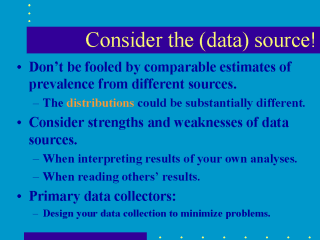 |
No data source
is perfect! Consequently, it is important to think about the strengths and weaknesses of
the source or sources of data that were used to produce a given set of results when
interpreting those findings or comparing them to others. Careful consideration of
potential biases can help avert incorrect interpretation of results. Recall bias will
affect many retrospectively collected data. Selection bias can affect many databases that
include only a fraction of the desired population, such as when only some people visit the
health care providers from whom data were acquired. Thinking about data quality should
occur at several different phases of research, including preparation for data collection,
interpretation of one’s own research findings when writing a paper, and evaluation of
results in published research. For example, knowing some of the weaknesses of patient
reported health data, one could include definitions or prompts of health conditions on a
questionnaire, or use a symptom-based approach. An understanding of the pitfalls of data
source will help provide a sense of the limitations of a study’s findings and why they
may or may not be directly comparable to those of other studies.
 |
Go to Comment Form |
|